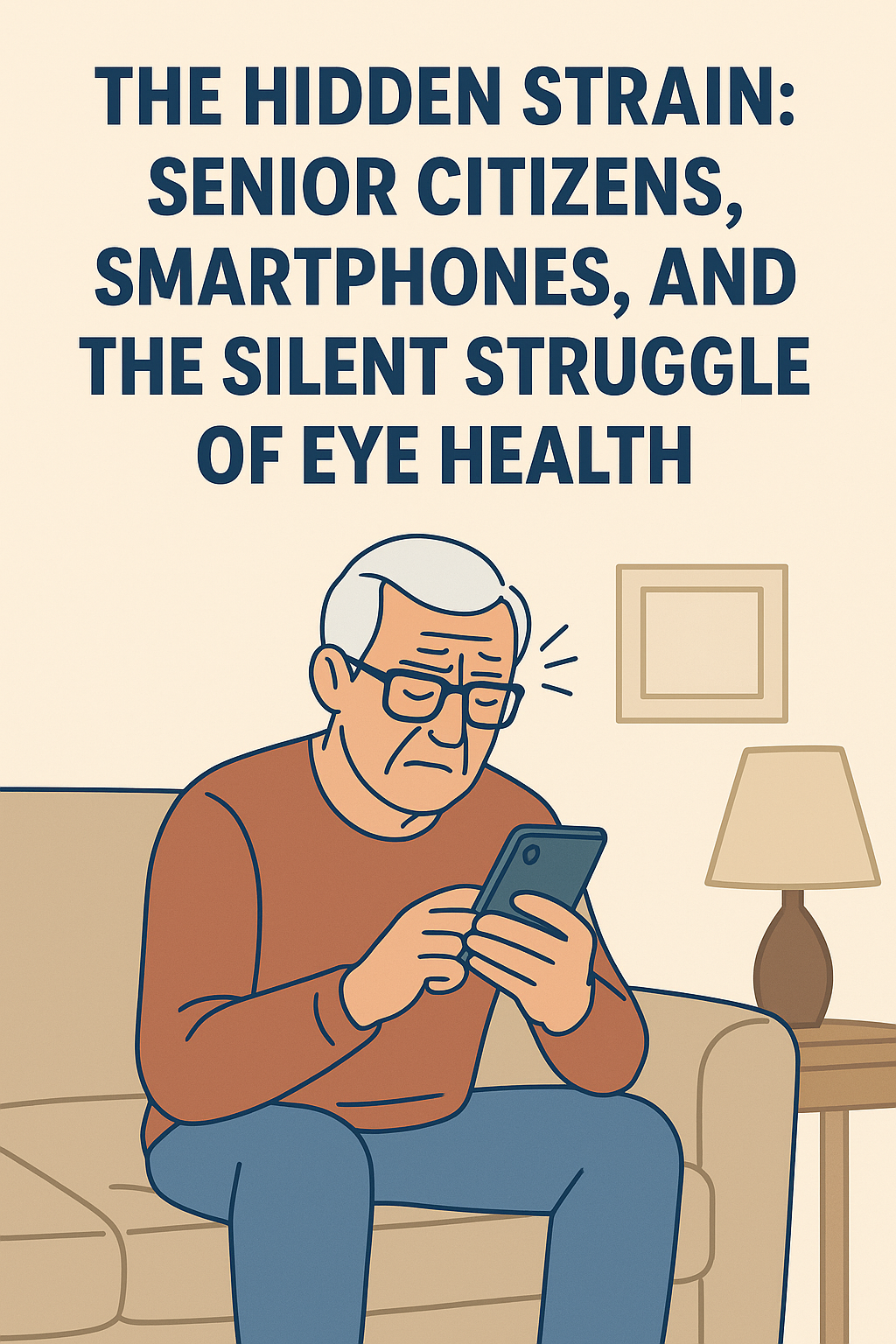Senior Citizens, Smartphones, and the Silent Struggle of Eye Health
When we think about the overuse of mobile phones, our minds often jump to teenagers endlessly scrolling through social media. But in recent years, a quiet yet growing trend has emerged: senior citizens spending hours—sometimes 10 to 12 or more each day—on their mobile phones. For many retired individuals, the phone has become both a companion and a window to the world. It keeps them busy, entertained, and connected. Yet, beneath the convenience and comfort lies a problem that often goes unnoticed—its impact on their eyes and overall well-being.
Retirement, while often celebrated as a time of rest, can also be a stage where loneliness and boredom creep in. Many senior citizens find themselves at home, with days stretching long and routines shrinking. With children busy in their own careers, friends scattered, and reduced opportunities to engage in community activities, the smartphone naturally becomes their closest companion. It fills the silence—offering TV shows, WhatsApp groups, YouTube videos, devotional songs, news updates, and even casual games. Seniors might begin their mornings checking messages and spend afternoons scrolling through Facebook reels or watching long religious discourses. Before they realize, hours pass, and by the end of the day, their screen time rivals or even exceeds that of teenagers. While this digital engagement offers comfort, entertainment, and a sense of connection, it comes at a hidden cost.
The Strain We Don’t Talk About: Eyes Under Pressure
The human eye was never designed to stare at glowing screens for hours on end—especially not as we age. With age, the eyes undergo natural changes:
-
The lens stiffens, leading to presbyopia (difficulty focusing on close objects).
-
The tear film diminishes, making eyes more prone to dryness.
-
The retina becomes more vulnerable to damage from prolonged exposure to light.
Add to this 12+ hours of mobile screen time, and the effects multiply:
1. Digital Eye Strain
Symptoms like dryness, irritation, blurred vision, and headaches are now common in senior citizens glued to screens. Many complain of “burning eyes” in the evening or watery eyes after watching long videos.
2. Blue Light Exposure
Smartphones emit blue light that penetrates deep into the eye. While research is still ongoing, there are concerns that prolonged exposure may accelerate retinal damage and potentially increase the risk of macular degeneration—a leading cause of vision loss in older adults.
3. Sleep Disturbances
Many seniors watch videos or scroll on their phones late into the night, often while lying in bed. Blue light suppresses melatonin production, disrupting sleep cycles. Poor sleep, in turn, worsens eye strain and overall health.
4. Posture-Linked Strain
Using phones while lying down or slouching on sofas adds another layer of stress. Poor posture not only affects the spine but also increases pressure on eye muscles as seniors adjust viewing angles unnaturally.
Stories Behind the Screens
Consider Mr. Desai, a 68-year-old retired banker. His children live abroad, and his wife often spends afternoons napping. To fill the quiet, he spends his time on WhatsApp forwards and binge-watching devotional lectures on YouTube. By evening, his eyes feel heavy, and his vision turns blurry. He dismisses it as “just age catching up,” not realizing that his screen habits are worsening the problem.
Or take Mrs. Shah, a 72-year-old grandmother. She loves playing Candy Crush and watching cooking videos. But over time, her eyes water excessively, forcing her to visit an ophthalmologist. The doctor diagnoses her with severe dry eye syndrome aggravated by long screen hours.
These stories are not rare—they echo in countless households today.
What Can Be Done? Practical Solutions for Seniors
While smartphones are not going away, small lifestyle changes can protect eye health without taking away the joy of digital engagement.
-
The 20-20-20 Rule
Encourage seniors to follow this simple practice: every 20 minutes, look at something 20 feet away for at least 20 seconds. It relaxes the eye muscles and reduces strain. -
Use Blue Light Filters
Many smartphones now come with “night mode” or “blue light filter” settings. Keeping these on throughout the day can reduce exposure. -
Artificial Tears & Hydration
Dry eyes can be relieved with over-the-counter lubricating eye drops and by ensuring proper hydration. Seniors often don’t drink enough water, further worsening dryness. -
Encourage Outdoor Time
A short walk in natural daylight not only benefits physical health but also gives eyes the much-needed break from screens. -
Limit Bedtime Usage
Using phones an hour before sleep should be discouraged. Reading a physical book, listening to soft music, or practicing light meditation can replace late-night scrolling. -
Regular Eye Checkups
Many seniors visit doctors only when vision becomes severely blurred. Regular eye exams can detect early signs of cataracts, glaucoma, or macular degeneration—conditions that screen overuse may accelerate.
A Shared Responsibility
This issue is not just about senior citizens—it’s also about families. Often, children are aware of their parents’ excessive phone use but hesitate to intervene. Gentle encouragement, setting up hobbies, or engaging seniors in conversations can help break the cycle. Even something as simple as teaching them new offline activities like gardening, painting, or puzzles can reduce dependence on screens. For many senior citizens, smartphones are a bridge between isolation and connection. They provide joy, comfort, and even purpose in an otherwise quiet routine. But when reliance turns into overuse, the very tool that keeps them connected can silently rob them of their vision. The challenge is not to take away the phone but to bring awareness, balance, and healthier habits. After all, protecting their eyes means preserving their independence, dignity, and quality of life in the years ahead.

